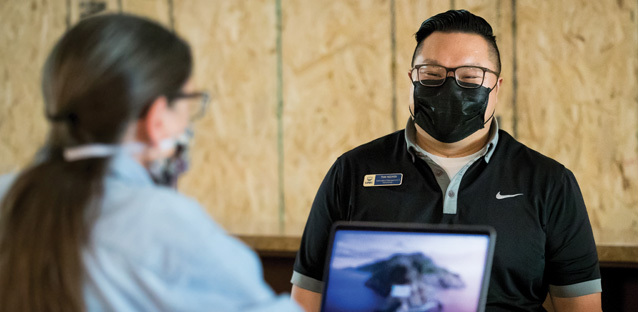When the decision was made to move classes online and send faculty and staff off campus to work remotely, the undertaking involved 11,000 students and 1,700 university employees increasing their technology use very quickly to a new level.
When the university closed and faculty, staff and students began working and attending class remotely, technology became a big factor in their success. From March 23 to April 22, the Information, Management and Technology (IM&T) team received more than 2,100 tickets requesting help and received more than 725 phone calls on assisting campus tech users.
The biggest transition was moving in-person classes to virtual instruction through programs like Canvas and Zoom. Instructional Design and Development, the Center for the Enhancement of Teaching and Learning (CETL), Human Resources, and IM&T all came together to accomplish this vital need.
The teams worked on a wide range of tasks — from enabling the satisfactory/unsatisfactory grading option to removing holds on student accounts. They provided tools to allow for virtual counseling and advising and did preventative work against phishing attacks.
Bret Naber, the IM&T chief information officer, said that UNC’s IM&T team was well-positioned to assist the campus community in the transformation from in-person to online environments. Foresight from tech experts, funding for scalable tools and outstanding implementation were the reasons the team was able to do so much, so quickly.
“We were able to take advantage of the tools we already own and utilize, and this positioned us very well to troubleshoot, support and train staff, faculty and students,” he says.
UNC has an account with Microsoft 365, which includes Microsoft Teams, a communication and collaboration platform that allows video chat, file sharing, project management and other tools. Here’s a snapshot of the usage numbers within Microsoft Teams before and after Colorado’s Stay-at-Home order took place:
- 85% increase in daily average users (700 per day before vs. 1,300 per day after)
- 166% increase in daily average messages sent (2,150 per day before vs. 8,385 per day after)
- 13,085% increase in daily average meetings (three per day before vs. 369 per day after)
It was an effort across divisions, as well. Faculty members needed further assistance from Instructional Design and Development and the Canvas team to train, develop and deploy courses to their students. And, with the help of the University Libraries, more than 100 laptops for students and more than 60 laptops for faculty and staff were loaned out. Dozens of monitors, webcams and other accessories were also loaned to faculty and staff members to increase productivity at home.
But part of the remote work success the university has had is owed to an effort that started five years ago to transition employees to laptop computers. Desktop Support Manager Chad Pohja explains that these early procedures made the move off campus much smoother. “UNC employees were quickly able to take their work computers home and be productive,” he says. And, since the university had already moved many of UNC’s core services (such as email, file storage and authentication) to the Microsoft’s cloud infrastructure, Pohja says it was a fairly seamless transition.
Nick Hoyle, assistant director of Business Analysis and Application Support, agrees. “I feel we were incredibly prepared. We have an amazing team that’s been future proofing for all situations we could potentially encounter for many years – from the most simplistic to the most devastating, rare and complex situations. The difficulty is having to make tough decisions around the local hardware infrastructure aspects of our environments, and when/how we can/should access these environments for maintenance to make sure we stay on track with our future proofing and normal maintenance.”
The teams continue to improve the systems and assist campus members with their technological and virtual needs.
“The staff in IM&T are some of brightest and most committed staff you could ever find,” Naber said. “I am humbled by their level of skill and care for the institution.”
Brad Sharp, director of Infrastructure and Support Services also complimented the team effort. “I would just add that I’m amazed how efficiently and quickly everything came together,” he says. “It’s surreal for me to think back to two months ago (it seems like two years ago) and see everything we’ve accomplished. Everyone did their part with a positive energy and a genuine desire to help. I couldn’t be prouder of our department.” UNC
–By Katie-Leigh Corder


